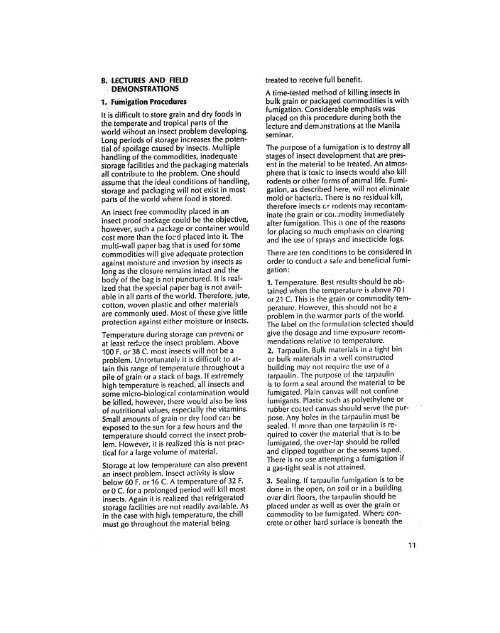I AR Pest control - USAid
I AR Pest control - USAid
I AR Pest control - USAid
You also want an ePaper? Increase the reach of your titles
YUMPU automatically turns print PDFs into web optimized ePapers that Google loves.
B. LECTURES AND FIELD<br />
DEMONSTRATIONS<br />
1. Fumigation Procedures<br />
It isdifficult to store grain and dry foods in<br />
thetemperate the~emprateandtropcalpart<br />
and tropical parts ofthelecture<br />
world Wihout an insect problem developing,<br />
Long periods of storage increases the potential<br />
of spoilage caused by insects. Multiple<br />
handling of the commodities, inadequate<br />
storage facilities and the packaging materials<br />
all contribute to the problem. One should<br />
assume that the ideal conditions of handling,<br />
storage and packaging will not exist in most<br />
parts of the world where food isstored.<br />
An insect free commodity placed in an<br />
insect proof oackage could be the objective,<br />
however, such a package or container would<br />
cost more than the focd placed into it. The<br />
multi-wall paper bag that isused for some<br />
commodities will give adequate protection<br />
against moisture and invasion by insects as<br />
long as the closure remains intact and the<br />
body of the bag is not punctured. It is realized<br />
that the special paper bag isnot available<br />
in all parts of the world. Therefore, jute,<br />
cotton, woven plastic and other materials<br />
are commonly used. Most of these give little<br />
protection against either moisture or insects.<br />
Temperature during storage can prevent or<br />
at least reduce the insect problem. Above<br />
100 F.or 38 C.most insects will not be a<br />
problem. Untortunately it isdifficult to attain<br />
this range of temperature throughout a<br />
pile of grain or a stack of bags. If extremely<br />
high temperature is reached, all insects and<br />
some micro-biological contamination would<br />
be killed, however, there would also be loss<br />
of nutritional values, especially the vitamins,<br />
Small amounts of grain or dry food cai: be<br />
exposed to the sun for a few hours and the<br />
temperature should correct the insect problem.<br />
However, it is realized this isnot practical<br />
for a large volume of material,<br />
Storge teperaurea t lo ecan also prevent<br />
an insect problem. Insect activity isslow<br />
below 60 F.or 16 C.A temperature of 32 F.<br />
or 0 C. for a prolonged period will kill most<br />
insects. Again it is realized that refrigerated<br />
storage facilities are not readily available. As<br />
in the case with high temperature, the chill<br />
must go throughout the material being<br />
treatedto receive full benefit.<br />
A time-tested method of killing insects in<br />
bulk grain or packaged commodities iswith<br />
ftmigation. Considerable emphasis was<br />
placed on and this demanstrations procedure during at the both Manila the<br />
seminar.<br />
The purpose of a fumigation is to destroy all<br />
stages of insect development that are present<br />
in the material to be treated. An atmosphere<br />
that is toxic to insects would also kill<br />
rodents or other forms of animal life. Fumigation,<br />
as described here, will not eliminate<br />
mold or bacteria. There isno residual kill,<br />
therefore insects cr rodents may recontammate<br />
the grain or coi.;modity immediately<br />
after fumigation. This isone of the reasons<br />
for placing so much emphasis on cleaning<br />
and the use of sprays and insecticide fogs.<br />
There are ten conditions to be considered in<br />
order to conduct a safe and beneficial fumigation:<br />
1. Temperature. Best results should be obtaied<br />
when the temperature isabove 70 I<br />
or 21 C.This is the grain or commoditytemperature.<br />
However, this should not be a<br />
problem in the warmer parts of the world.<br />
The label on the formulation selected should<br />
give the dosage and time expo ure recommendations<br />
relative to temperature.<br />
2. Tarpaulin. Bulk materials in a tight bin<br />
or bulk materials in awell constructed<br />
building may not require the use of a<br />
tarpaulin. The purpose of the tarpaulin<br />
isto form aseal around the material to be<br />
fumigated. Plain canvas will not confine<br />
fumigants. Plastic such as polyethylene or<br />
rubber co,.ted canvas should serve the purpose.<br />
Any holes in the tarpaulin must be<br />
sealed. if more than one tarpaulin is required<br />
to cover the material that isto be<br />
fumigated, the over-lap should be rolled<br />
and clipped together or the seams taped.<br />
There is no use attempting a fumigation if<br />
gas-tight seal is not attained.<br />
g g<br />
3. Sealing. If tarpaulin fumigation isto be<br />
done in the open, on soil or in a building<br />
over dirt floors, the tarpaulin should be<br />
placed under as well as over the grain or<br />
commodity to be fumigated. Where concrete<br />
or other hard surface is beneath the<br />
11

















